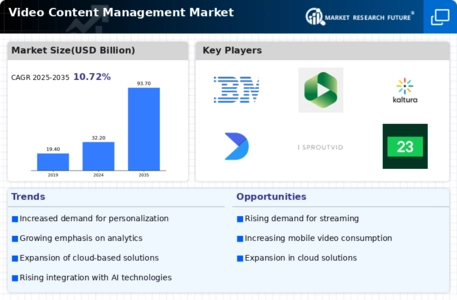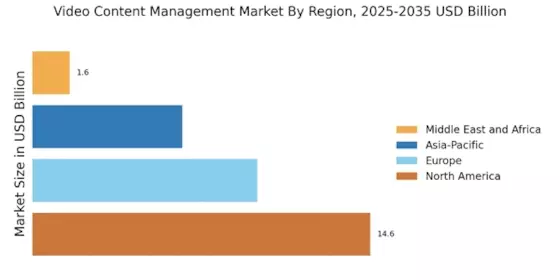Rising Demand for Video Content
The increasing consumption of video content across various platforms appears to be a primary driver for the Video Content Management Market. With the proliferation of social media and streaming services, organizations are compelled to produce and manage vast amounts of video content. According to recent statistics, video content is projected to account for over 80% of all internet traffic by 2025. This surge in demand necessitates robust video content management solutions that can efficiently handle storage, retrieval, and distribution. As businesses recognize the importance of engaging video content in their marketing strategies, the Video Content Management Market is likely to experience substantial growth, driven by the need for effective content management systems that can streamline workflows and enhance viewer engagement.
Growing Importance of Video Marketing
The growing importance of video marketing is a significant driver for the Video Content Management Market. Businesses are increasingly leveraging video as a powerful tool to engage customers and promote their products or services. Research indicates that video marketing can lead to a 66% increase in qualified leads per year. As companies recognize the effectiveness of video in driving conversions and brand awareness, they are investing in video content management solutions to optimize their marketing efforts. This trend is expected to propel the Video Content Management Market forward, as organizations seek to create, manage, and analyze video content to maximize their marketing return on investment.
Emphasis on Data Analytics and Insights
The emphasis on data analytics and insights is becoming increasingly relevant in the Video Content Management Market. Organizations are recognizing the value of data-driven decision-making in optimizing video content strategies. By leveraging analytics, businesses can gain insights into viewer behavior, engagement metrics, and content performance. This information is crucial for refining marketing strategies and enhancing audience targeting. As a result, video content management solutions that incorporate robust analytics capabilities are in high demand. The Video Content Management Market is likely to see growth as companies invest in technologies that enable them to analyze and leverage video data effectively, ultimately driving better business outcomes.
Adoption of Mobile and Remote Work Solutions
The shift towards mobile and remote work solutions has significantly influenced the Video Content Management Market. As organizations adapt to flexible work environments, the need for accessible and efficient video content management systems becomes paramount. Employees require the ability to access, share, and collaborate on video content from various locations and devices. This trend is supported by data indicating that remote work has increased productivity and employee satisfaction. Consequently, video content management solutions that offer mobile compatibility and cloud-based access are in high demand. The Video Content Management Market is likely to expand as companies invest in technologies that facilitate seamless video collaboration and enhance communication among remote teams.
Technological Advancements in Video Production
Technological advancements in video production are reshaping the Video Content Management Market. Innovations such as high-definition video, 360-degree video, and virtual reality are transforming how content is created and consumed. These advancements necessitate sophisticated video content management systems that can accommodate diverse formats and enhance user experience. As production technologies evolve, the demand for effective management solutions that can handle high-quality video content is likely to increase. The Video Content Management Market is expected to benefit from these technological trends, as organizations seek to adopt cutting-edge tools that facilitate the creation and distribution of immersive video experiences.


















Leave a Comment